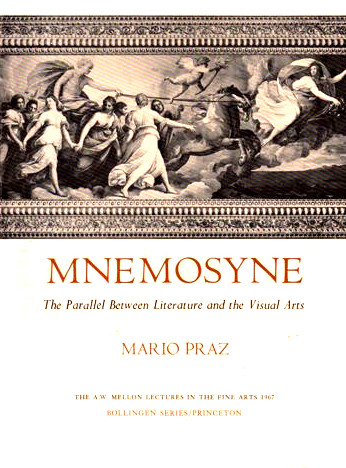Mario Praz: Mnemosyne: The Parallel Between Literature and the Visual Arts (1970–) [English, Spanish]
Filed under book | Tags: · art, art history, art theory, history of literature, literary theory, literature, memory, poetry

In his search for the common link between literature and the visual arts, Professor Praz draws upon the abundant evidence of long mutual understanding and correspondence between the sister arts. Although parallels of theme and inspiration are plentiful, he is not primarily concerned with these. Rather, he examines the close relationship or air de famille between the expression of the arts in any given epoch.
Each epoch has “its peculiar handwriting or handwritings, which, if one could interpret them, would reveal a character, even a physical appearance.” Although handwriting is taught and some of its characteristics thus belong to the general style of the period, the personality of the writer does not fail to pierce through. Something of the same sort, the author proposes, occurs in art. The kinship of literature and painting rests on this circumstance: a work of art, whether visual or literary, must use the distinctive “handwriting” of its particular age, even as its originality pierces through this handwriting.
The likeness between the arts within various periods of history can ultimately be traced, then, to structural similarities — similarities that arise out of the characteristic way in which the people of a certain epoch see and memorize facts aesthetically. Mnemosyne, at once the goddess of memory and the mother of the muses, therefore presides over this view of the arts. In illustrating her influence, Professor Praz ranges widely through Western sources, both literary and pictorial. (from the dust jacket)
The A.W. Mellon Lectures in the Fine Arts, 1967
Publisher Princeton University Press, 1970
Bollingen Series XXXV, 16
ISBN 9780691098579
261 pages
Review (E.H. Gombrich, 1972)
Review (D.C., Spenser Newsletter, page 3, 1971)
Review (in Japanese)
Publisher (EN)
Mnemosyne: The Parallel between Literature and the Visual Arts (English, 1970)
Mnemosyne: El paralelismo entre la literatura y las artes visuales (Spanish, trans. Ricardo Pochtar, 1979, no OCR, via Daniel Ferreira)
Matthew Fuller, Andrew Goffey: Evil Media (2012)
Filed under book | Tags: · algorithm, art, artificial intelligence, business, code, computing, data, database, event, governance, information, interaction, interface, knowledge, labour, language, machine, management, market, media, media theory, memory, military, networks, philosophy, political theory, politics, power, programming, software

“Evil Media develops a philosophy of media power that extends the concept of media beyond its tried and trusted use in the games of meaning, symbolism, and truth. It addresses the gray zones in which media exist as corporate work systems, algorithms and data structures, twenty-first century self-improvement manuals, and pharmaceutical techniques. Evil Media invites the reader to explore and understand the abstract infrastructure of the present day. From search engines to flirting strategies, from the value of institutional stupidity to the malicious minutiae of databases, this book shows how the devil is in the details.
The title takes the imperative “Don’t be evil” and asks, what would be done any differently in contemporary computational and networked media were that maxim reversed.
Media here are about much more and much less than symbols, stories, information, or communication: media do things. They incite and provoke, twist and bend, leak and manage. In a series of provocative stratagems designed to be used, Evil Media sets its reader an ethical challenge: either remain a transparent intermediary in the networks and chains of communicative power or become oneself an active, transformative medium.”
Publisher MIT Press, 2012
ISBN 0262304406, 9780262304405
235 pages
Review: Nicholas Holm (Media Int’l AU, 2013), Neural (2013).
Evil media on Monoskop wiki
PDF (updated on 2024-4-13)
HTML (added on 2015-8-28)
See also YoHa, et al., Evil Media Distribution Centre, 2013.
Comments (2)Wolfgang Ernst: Digital Memory and the Archive (2012)
Filed under book | Tags: · archive, art, communication, computing, culture, data, history, information, internet, knowledge, machine, media, media archeology, media studies, media theory, memory, photography, radio, sound, storage, technology, television, temporality, time

“In the popular imagination, archives are remote, largely obsolete institutions: either antiquated, inevitably dusty libraries or sinister repositories of personal secrets maintained by police states. Yet the archive is now a ubiquitous feature of digital life. Rather than being deleted, e-mails and other computer files are archived. Media software and cloud storage allow for the instantaneous cataloging and preservation of data, from music, photographs, and videos to personal information gathered by social media sites.
In this digital landscape, the archival-oriented media theories of Wolfgang Ernst are particularly relevant. Digital Memory and the Archive, the first English-language collection of the German media theorist’s work, brings together essays that present Ernst’s controversial materialist approach to media theory and history. His insights are central to the emerging field of media archaeology, which uncovers the role of specific technologies and mechanisms, rather than content, in shaping contemporary culture and society.
Ernst’s interrelated ideas on the archive, machine time and microtemporality, and the new regimes of memory offer a new perspective on both current digital culture and the infrastructure of media historical knowledge. For Ernst, different forms of media systems—from library catalogs to sound recordings—have influenced the content and understanding of the archive and other institutions of memory. At the same time, digital archiving has become a contested site that is highly resistant to curation, thus complicating the creation and preservation of cultural memory and history. ”
Edited and with an Introduction by Jussi Parikka
Publisher University of Minnesota Press, 2012
Volume 39 of Electronic Mediations
ISBN 0816677670, 9780816677672
265 pages
Reviews: Liam Cole Young (Reviews in Cultural Theory, 2013), Peter Ward (Information & Culture, 2014).
For more from Wolfgang Ernst see Monoskop wiki.
Comment (0)
